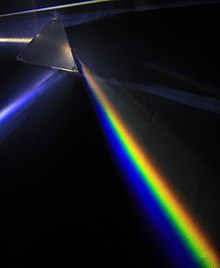The visible spectrum is the portion of the electromagnetic spectrum that can be detected by the human eye[1]. It consists of wavelengths ranging from approximately 380 to 750 nanometers, corresponding to frequencies between 400 and 790 terahertz[1]. This range of light is what we perceive as colors, from violet at the shortest wavelengths to red at the longest.
Key characteristics of the visible spectrum:
- Wavelength range: 380-750 nm
- Frequency range: 400-790 THz
- Perceived as colors by the human eye
- Passes largely unattenuated through Earth’s atmosphere
The visible spectrum is often divided into spectral colors, which are pure colors produced by monochromatic light:
| Color | Wavelength (nm) | Frequency (THz) |
|---|---|---|
| Violet | 380-450 | 670-790 |
| Blue | 450-485 | 620-670 |
| Cyan | 485-500 | 600-620 |
| Green | 500-565 | 530-600 |
| Yellow | 565-590 | 510-530 |
| Orange | 590-625 | 480-510 |
| Red | 625-750 | 400-480 |
It’s important to note that the spectrum is continuous, and these color boundaries are approximate[1].
Historical development:
- 13th century: Roger Bacon theorized about rainbows and light passing through glass
- 17th century: Isaac Newton discovered prisms could disassemble and reassemble white light
- 18th century: Johann Wolfgang von Goethe wrote about optical spectra in his “Theory of Colours”
- Early 19th century: William Herschel discovered infrared light, and Johann Wilhelm Ritter discovered ultraviolet light
- 19th century: Thomas Young and Hermann von Helmholtz explored the connection between the visible spectrum and color vision[1]
Limits of human vision:
The visible range is limited by several factors:
- Atmospheric transmission: The ozone layer absorbs most UV light below 315 nm
- Ocular transmission: The cornea and lens filter out UVB and UVA light
- Opsin absorption: The spectral sensitivity of visual opsins determines the range of light that can be perceived[1]
Under ideal conditions, humans may perceive:
- Infrared light up to 1,064 nm
- Ultraviolet light down to 310-313 nm[1]
Non-human vision:
The visible spectrum varies greatly among different species:
- Most mammals are dichromatic, with two opsin classes
- Birds, lizards, and fish are often tetrachromatic, with four opsin classes
- Some invertebrates, like mantis shrimp, have up to 14 opsins
- Many insects, including bees, can detect ultraviolet light
- Some snakes can detect infrared radiation for thermal vision[1]
Applications:
Spectroscopy, the study of objects based on their emitted, absorbed, or reflected spectrum, is a crucial tool in various fields:
- Astronomy: Analyzing properties of distant objects
- Chemical analysis: Detecting elements and molecules
- Doppler shift measurement: Determining velocities of celestial objects[1]
The visible spectrum plays a vital role in our daily lives, from how we perceive the world around us to its applications in science and technology. Understanding its properties and limitations helps us better comprehend both human vision and the diverse visual capabilities of other species.
[glossary_wikipedia]The visible spectrum is the band of the electromagnetic spectrum that is visible to the human eye. Electromagnetic radiation in this range of wavelengths is called visible light (or simply light). The optical spectrum is sometimes considered to be the same as the visible spectrum, but some authors define the term more broadly, to include the ultraviolet and infrared parts of the electromagnetic spectrum as well, known collectively as optical radiation.

A typical human eye will respond to wavelengths from about 380 to about 750 nanometers. In terms of frequency, this corresponds to a band in the vicinity of 400–790 terahertz. These boundaries are not sharply defined and may vary per individual. Under optimal conditions, these limits of human perception can extend to 310 nm (ultraviolet) and 1100 nm (near infrared).
The spectrum does not contain all the colors that the human visual system can distinguish. Unsaturated colors such as pink, or purple variations like magenta, for example, are absent because they can only be made from a mix of multiple wavelengths. Colors containing only one wavelength are also called pure colors or spectral colors.
Visible wavelengths pass largely unattenuated through the Earth's atmosphere via the "optical window" region of the electromagnetic spectrum. An example of this phenomenon is when clean air scatters blue light more than red light, and so the midday sky appears blue (apart from the area around the Sun which appears white because the light is not scattered as much). The optical window is also referred to as the "visible window" because it overlaps the human visible response spectrum. The near infrared (NIR) window lies just out of the human vision, as well as the medium wavelength infrared (MWIR) window, and the long-wavelength or far-infrared (LWIR or FIR) window, although other animals may perceive them.